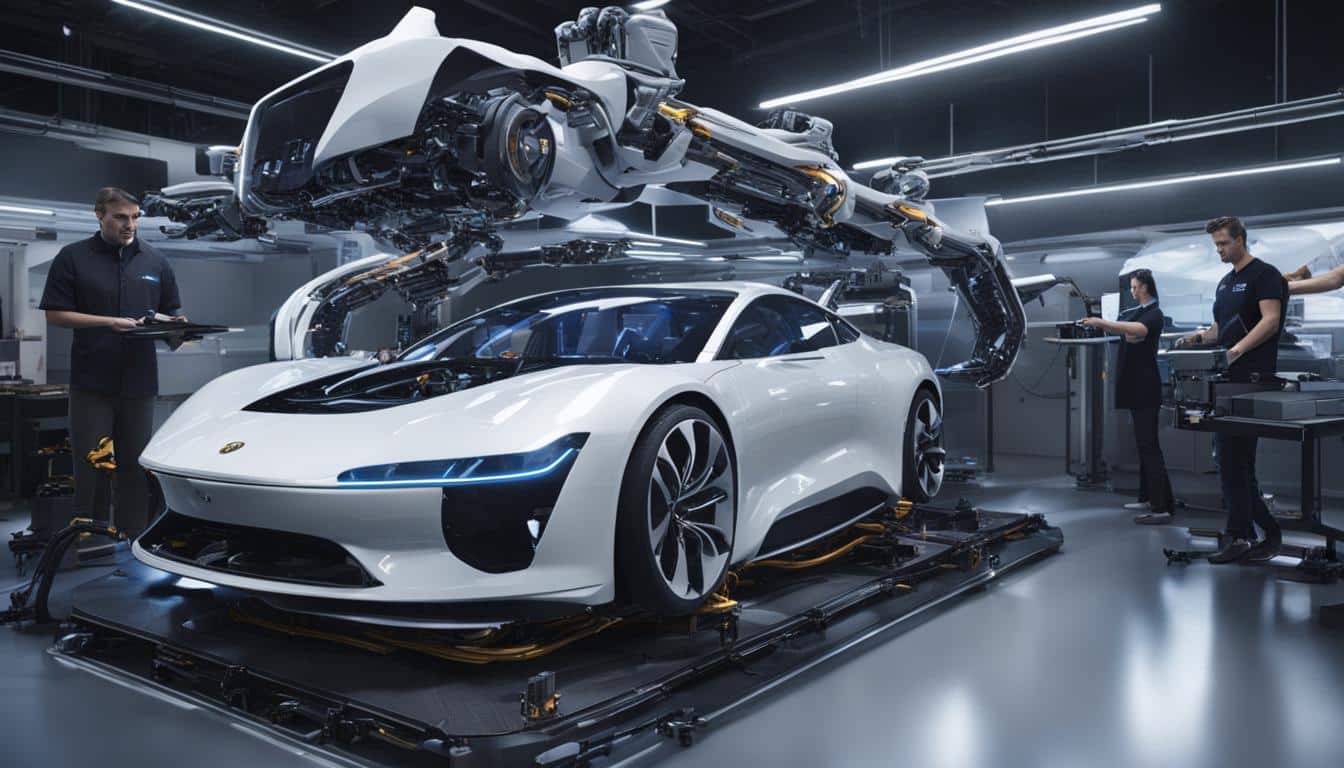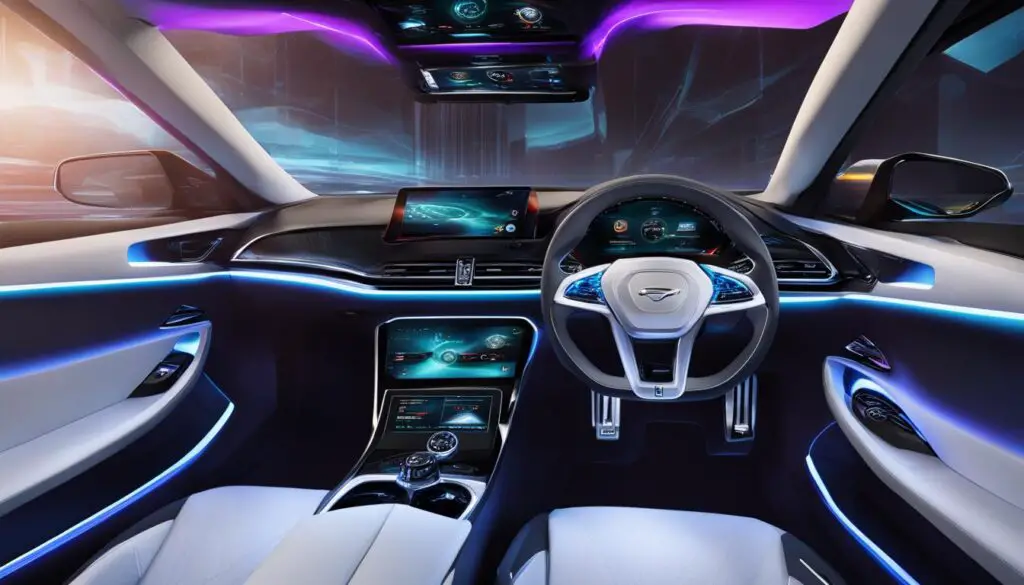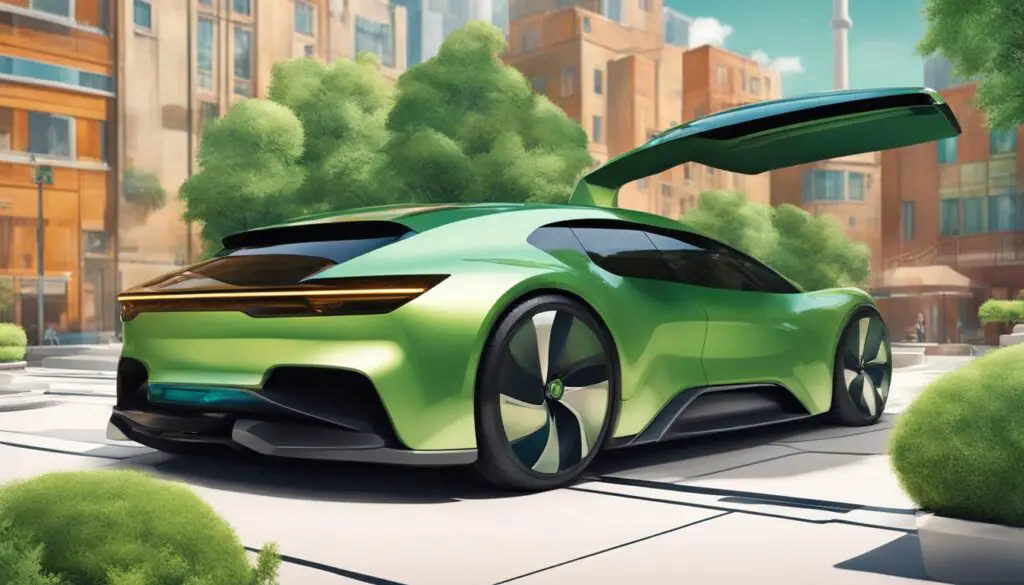
The Future of Automotive Design: Trends and Innovations
The automotive industry is constantly evolving, and the future of automotive design holds exciting trends and innovations that will shape tomorrow’s vehicles. From advancements in artificial intelligence (AI) and cloud computing to the integration of virtual assistants and enhanced user experiences, the automotive industry is at the forefront of technological advancements. In this article, I will explore the future trends in automotive design and functionality that are set to revolutionize the way we drive.
Integration of AI and Cloud Computing in Automotive Design
The integration of AI and cloud computing is revolutionizing automotive design and functionality. With AI technology, vehicles can analyze and process data in real-time, leading to the development of advanced driver assistance systems (ADAS) and autonomous driving capabilities.
AI-powered vehicles can navigate complex roadways, adapt to changing traffic conditions, and make informed decisions to enhance safety and efficiency. By utilizing cloud computing, vehicles can access and share data with other vehicles, infrastructure, and devices, creating a seamless network of communication.
This connectivity facilitates the exchange of information, such as traffic updates and road hazards, enabling vehicles to anticipate and address potential risks. Additionally, cloud computing allows for over-the-air updates, ensuring that vehicles always have the latest software and functionalities.
Moreover, AI and cloud computing enable personalized user experiences. Vehicles can learn from user preferences, analyze environmental data, and adapt their settings and features accordingly. Whether it’s adjusting the temperature, suggesting alternate routes, or providing entertainment recommendations, AI-powered vehicles can intelligently cater to individual needs.
“The integration of AI and cloud computing in automotive design unlocks a plethora of possibilities for safer, smarter, and more personalized driving experiences.”
Furthermore, AI and cloud computing play a vital role in enhancing vehicle security. By leveraging AI algorithms and cloud data centers, automotive manufacturers can detect and respond to potential cybersecurity threats in real-time, ensuring the integrity and privacy of vehicle and driver information.
| Benefits of AI in Automotive Design | Benefits of Cloud Computing in the Automotive Industry |
|---|---|
|
|
The integration of AI and cloud computing in automotive design represents a pivotal step towards a future of intelligent, connected, and safe transportation. As technology continues to advance, the automotive industry will leverage these innovations to shape the next generation of vehicles, redefining the way we drive and experience mobility.
Virtual Assistants and Hyper-Personalized User Experience
Virtual assistants are revolutionizing the automotive industry by seamlessly integrating with vehicles, enhancing the driver-car relationship, and providing a hyper-personalized user experience. These intelligent digital companions, such as Mercedes-Benz’s MBUX Virtual Assistant, leverage advanced software and generative AI to engage in natural conversations with drivers, offering proactive support and intuitive interactions that cater to their individual needs.
With virtual assistants, drivers can simply use voice commands or natural language to control various aspects of their vehicle, such as adjusting temperature settings, selecting music playlists, or navigating to a desired destination. These smart assistants utilize high-resolution graphics and visual feedback to create an immersive and personalized driving experience, ensuring that drivers stay focused and connected safely throughout their journey.
One of the key benefits of virtual assistants in the automotive industry is the ability to learn and adapt to each driver’s preferences. Through continuous data analysis and machine learning algorithms, these assistants can understand personal driving habits, favorite destinations, and individual music preferences. This knowledge enables them to deliver tailored recommendations, making every drive a unique and enjoyable experience.
With virtual assistants, drivers can enjoy a truly personalized experience that caters to their preferences, needs, and even moods. These intelligent companions have the potential to transform the way we interact with our cars, seamlessly blending advanced technology with everyday driving.
Moreover, virtual assistants can provide valuable real-time information and assist drivers with tasks beyond the vehicle itself. For example, they can help find nearby restaurants, provide weather updates, or even schedule appointments with connected third-party services. This level of integration between the virtual assistant and the surrounding environment enhances convenience and ensures that drivers can focus on the road while staying connected to the world around them.
The Future of Virtual Assistants in the Automotive Industry
The future of virtual assistants in the automotive industry is promising, with continuous advancements being made to create even more intelligent and intuitive experiences. As technology evolves, virtual assistants will have the ability to anticipate drivers’ needs before they even express them, providing proactive recommendations for various aspects of the driving experience.
Additionally, virtual assistants will further integrate with other smart devices and IoT networks, allowing for seamless control and communication across different platforms. Imagine being able to adjust your home thermostat, turn on the lights, or even shop for groceries through voice commands while driving. The possibilities are endless.
As virtual assistants continue to evolve and enhance the driving experience, it is essential to ensure data privacy and security. Manufacturers must prioritize the protection of personal information and provide transparent policies regarding data collection and usage.
In conclusion, virtual assistants are transforming the automotive industry by offering a hyper-personalized user experience. These intelligent companions enhance driver-car interactions, providing seamless control, proactive support, and personalized recommendations. As virtual assistants continue to evolve, they will undoubtedly shape the future of automotive design, creating a more connected, intuitive, and enjoyable driving experience for all.
Enhanced Connectivity and Infotainment Options
Connectivity and infotainment options are at the forefront of automotive design, driving a new era of advanced functionality and seamless integration. With the rise of smart technology, vehicles are becoming increasingly connected, transforming the driving experience like never before.
Through connectivity features, such as Bluetooth and Wi-Fi, cars can effortlessly integrate with smartphones, IoT devices, and cloud services. This connectivity opens up a world of possibilities, enabling real-time navigation, music streaming, and voice commands for hands-free control.
One of the key advancements in automotive design is the integration of infotainment systems in vehicles. These systems provide a comprehensive suite of entertainment, productivity, and convenience options for drivers and passengers alike. From accessing favorite apps to streaming content, the infotainment system becomes the central hub of in-car entertainment.
An expanding portfolio of third-party apps further enriches the infotainment experience, allowing users to customize their driving environment based on personal preferences. Whether it’s listening to podcasts, checking the latest news, or ordering food delivery, the range of possibilities is vast.
In addition to entertainment features, connectivity in cars also enables enhanced safety and control. Remote vehicle control allows drivers to lock, unlock, or start their vehicles remotely, providing peace of mind and convenience. Moreover, real-time data exchange with cloud services empowers vehicles with up-to-date information on road conditions, weather updates, and traffic alerts.
By seamlessly integrating connectivity and infotainment options, automakers are redefining the driving experience, creating a connected ecosystem that keeps drivers informed, entertained, and in control. With each innovation, the future of automotive design becomes more engaging, convenient, and personalized.
“Connectivity and infotainment options are revolutionizing the automotive industry, creating a seamless and personalized driving experience.”
To illustrate the scope and impact of enhanced connectivity and infotainment options, let’s take a look at the following table:
| Connectivity Features | Benefits |
|---|---|
| Real-time navigation | Efficient and accurate route guidance |
| Music streaming | Access to a vast library of music and podcasts |
| Voice commands | Hands-free control for increased safety |
| Remote vehicle control | Convenience and peace of mind |
| Third-party apps | Customizable entertainment and productivity |

Maximizing Safety and Connectivity
As connectivity in cars continues to evolve, ensuring the safety of drivers and passengers remains a top priority. Automakers are implementing advanced security measures to protect against potential cyber threats and unauthorized access to vehicle systems.
Additionally, industry collaboration and standardization efforts are critical to establish consistent and secure connectivity protocols across different vehicles and manufacturers. This ensures interoperability and a seamless experience for all users.
Overall, enhanced connectivity and infotainment options are transforming automotive design, allowing for a truly immersive and personalized driving experience. As technology continues to advance, we can expect even greater integration, convenience, and entertainment options in the cars of the future.
Sustainability and Environmental Considerations
As the world becomes more environmentally conscious, sustainability plays a crucial role in automotive design. Manufacturers are focusing on developing eco-friendly vehicles by using sustainable materials, reducing emissions, and implementing energy-efficient technologies. Innovations such as pearlescent pigments, low VOC volume paints, and natural pearl essence in personal care products contribute to a greener and more sustainable automotive industry. The adoption of sustainable practices not only benefits the environment but also meets the growing demand from consumers for eco-conscious vehicles.
The use of sustainable materials in automotive design has gained significant attention in recent years. As the demand for eco-friendly cars continues to rise, manufacturers are exploring alternative materials that have a lower carbon footprint and are recyclable. Some examples of eco-friendly materials used in cars include:
| Material | Advantages |
|---|---|
| Recycled Plastics | Reduce waste and dependence on petroleum-based plastics |
| Natural Fibers | Renewable, biodegradable, and lightweight |
| Bamboo | Sustainable, strong, and lightweight |
| Plant-Based Foams | Reduce reliance on petroleum-based materials |
| Recycled Metals | Reduce energy consumption and mining waste |
By incorporating these eco-friendly materials into car manufacturing, automakers are not only reducing their carbon footprint but also contributing to the preservation of natural resources.
In addition to sustainable materials, automotive designers are implementing various energy-efficient technologies to minimize the environmental impact of vehicles. Innovations such as regenerative braking, solar panels, and lightweight construction help improve fuel efficiency and reduce emissions. These advancements not only benefit the environment but also result in cost savings for consumers through reduced fuel consumption.
Furthermore, automotive designers are actively working towards making the production processes more sustainable. Many manufacturers are adopting cleaner and more efficient manufacturing techniques, reducing water consumption, and incorporating renewable energy sources into their production facilities. By embracing sustainability throughout the entire lifecycle of a car, from the design phase to manufacturing and beyond, the automotive industry is making significant strides towards a greener and more sustainable future.

By prioritizing sustainability in automotive design, manufacturers can fulfill the growing demand for eco-friendly vehicles while reducing their overall impact on the environment. The adoption of sustainable materials, energy-efficient technologies, and cleaner manufacturing processes demonstrates a commitment to a greener future and offers consumers more eco-conscious alternatives in the automotive market.
Conclusion
The future of automotive design is poised to be a game-changer, as ongoing advancements in AI, cloud computing, virtual assistants, connectivity, and sustainability continue to shape the industry. These trends pave the way for enhanced functionality and experiences, revolutionizing the way we drive.
As technology evolves, we can expect even more groundbreaking innovations in automotive design that prioritize safety, efficiency, and environmental sustainability. Intelligent systems powered by AI enable vehicles to analyze real-time data, empowering advanced driver assistance systems (ADAS) and autonomous driving capabilities. Cloud computing facilitates seamless connectivity between vehicles, infrastructure, and other devices, streamlining communication and improving user experience.
Virtual assistants like Mercedes-Benz’s MBUX Virtual Assistant are transforming the driver-car relationship, providing hyper-personalized user experiences. Through natural conversations and intuitive interactions, these virtual assistants offer proactive support, backed by generative AI and high-resolution graphics. Additionally, the growing connectivity in vehicles opens up a world of infotainment options, including real-time navigation, music streaming, voice commands, and third-party app integration, enhancing the overall driving experience further.
Sustainability also takes center stage in automotive design, with manufacturers embracing eco-friendly materials, reducing emissions, and implementing energy-efficient technologies. From sustainable paints to innovative eco-conscious practices, the industry is committed to meeting the demand for more environmentally friendly vehicles.
The future of automotive design holds promise not only in transforming vehicles but also in making driving safer, more efficient, and environmentally sustainable. By embracing emerging technologies and focusing on user-centric experiences, the automotive industry is driving us toward a future where our vehicles are more than just modes of transportation – they are intelligent, connected, and environmentally conscious companions on the road.
FAQ
What are some future trends in automotive design and functionality?
The future of automotive design holds exciting trends and innovations. Some of the key trends include advancements in artificial intelligence (AI) and cloud computing, integration of virtual assistants, enhanced connectivity and infotainment options, and a focus on sustainability.
How is AI integrated into automotive design?
AI technology is revolutionizing automotive design and functionality. It enables vehicles to analyze and process data in real-time, enabling advanced driver assistance systems (ADAS) and autonomous driving capabilities. With AI, vehicles can learn from user preferences and environmental data to provide personalized and intelligent features.
What role does cloud computing play in automotive design?
Cloud computing enables seamless connectivity and communication between vehicles, infrastructure, and other devices. It improves safety, efficiency, and user experience by allowing vehicles to access real-time information and updates. Cloud computing also enables features like real-time navigation, music streaming, and voice commands.
How do virtual assistants enhance the driving experience?
Virtual assistants are becoming an integral part of the automotive industry, providing a hyper-personalized user experience. They engage in natural conversations with drivers, offering proactive support and intuitive interactions. Virtual assistants utilize high-resolution graphics and visual feedback to create a more immersive driving experience.
What are some connectivity and infotainment options in automotive design?
Vehicles are becoming increasingly connected, seamlessly integrating with smartphones, IoT devices, and cloud services. This connectivity enables features like real-time navigation, music streaming, voice commands, and remote vehicle control. Additionally, the expansion of third-party app portfolios provides users with a wide range of entertainment, productivity, and convenience options.
How is sustainability considered in automotive design?
Sustainability plays a crucial role in automotive design. Manufacturers are focusing on developing eco-friendly vehicles by using sustainable materials, reducing emissions, and implementing energy-efficient technologies. Innovations such as pearlescent pigments, low VOC volume paints, and natural pearl essence contribute to a greener and more sustainable automotive industry.
What can we expect for the future of automotive design?
The future of automotive design is bright, with trends and innovations that will revolutionize the way we drive. Advancements in AI, cloud computing, virtual assistants, connectivity, and sustainability are shaping the automotive industry and providing users with enhanced functionality and experiences. The focus will continue to be on safety, efficiency, and environmental sustainability.
